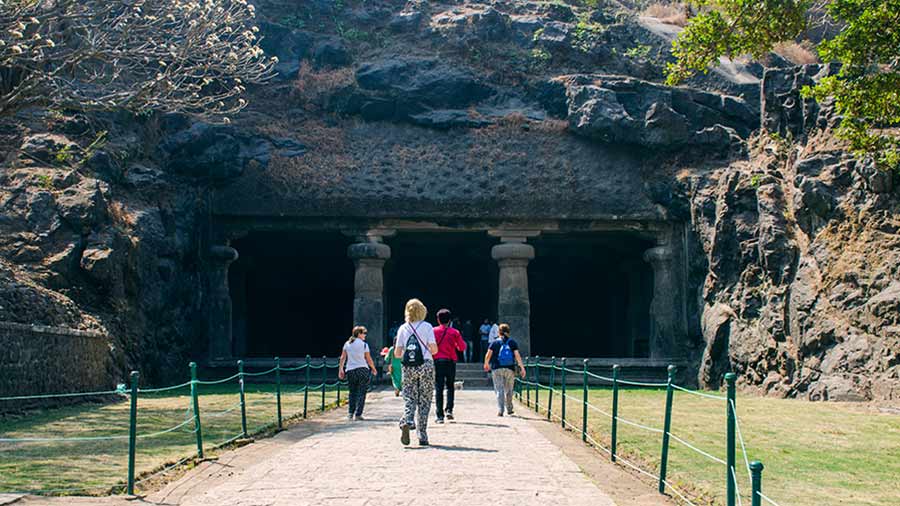[Continued from here]
The stair meanders past the artifacts and souvenir shops and leads to the Cave 1 of the Elephanta Caves. Cave 1 is the most spectacular of the caves of Elephanta. It is approached through a pillared entrance on the northern side and leads to an open space supported by decorative pillars. The cave houses a Shiva shrine and its walls are sculpted with intricate images depicting the life of Shiva.
The ‘Elephanta’ name has Portuguese heritage. The Portuguese were probably the first Europeans to arrive on the island. A huge elephant statue once stood on the island, and hence the name. The statue was later removed and can be seen in Mumbai Zoo (Veermata Jijabai Bhosale Udyan and Zoo). Nothing much is known about the history of the caves. Recent numismatic evidence, along with inscriptions and construction style, suggest that the caves were constructed by King Krishnaraja of the Kalachuri Dynasty and date back to the mid-sixth century.
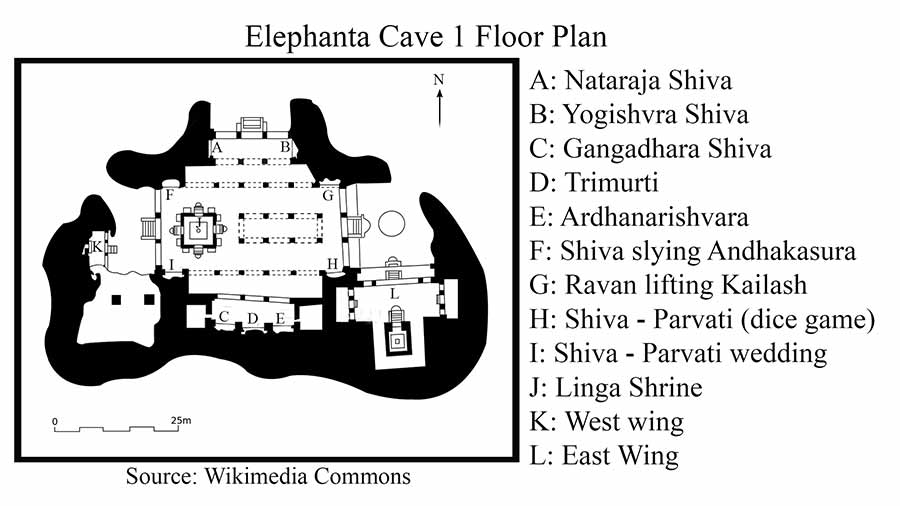
A floor plan of the caves
Nataraj (A on map): On the right of the entrance is Shiva as Nataraj, the king of the dancers. It is heavily damaged, with large portions of upper and lower limbs missing, but still has the beauty and grace with numerous figures in the background.
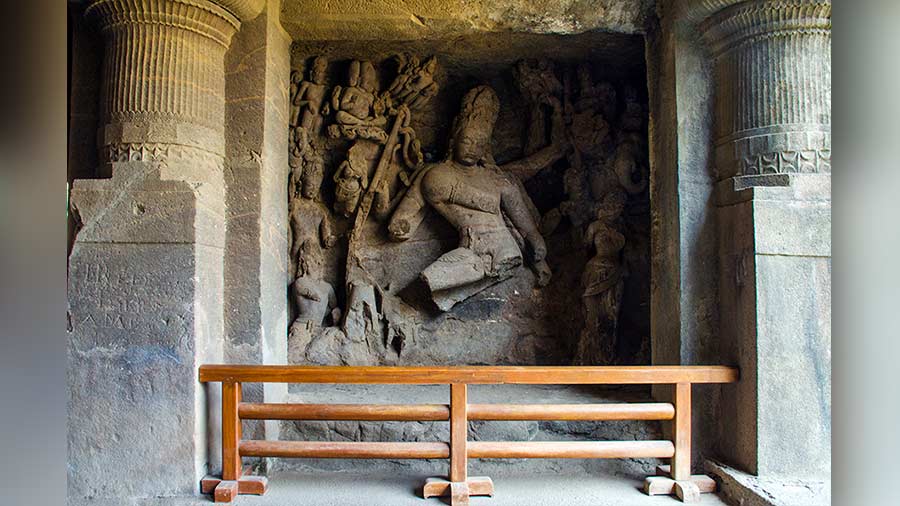
Shiva as Nataraj
Yogishvara (B on map): Bang opposite the Nataraj panel, and on the left side of the gateway, is a panel showing Shiva as Yogishvara, master of yoga. Here, Shiva is seated in padmasana posture and lost in his meditation. He wears a crown and his expresses great spiritual strength and calmness. Here, too, the statue is badly damaged with both the upper limbs completely broken. The background contains several smaller statues of gods and goddesses, as well as of monks and sadhus, creating a complex collage.

Shiva as Yogishvara, master of yoga
Trimurti (D on map): Trimurti, or Mahesh Murti, occupies the prime position of the Elephanta caves and is no wonder, the star attraction of the cave. It consists of a three-headed statue of Shiva. The three heads represent three essential aspects of Shiva: creation, protection and destruction.
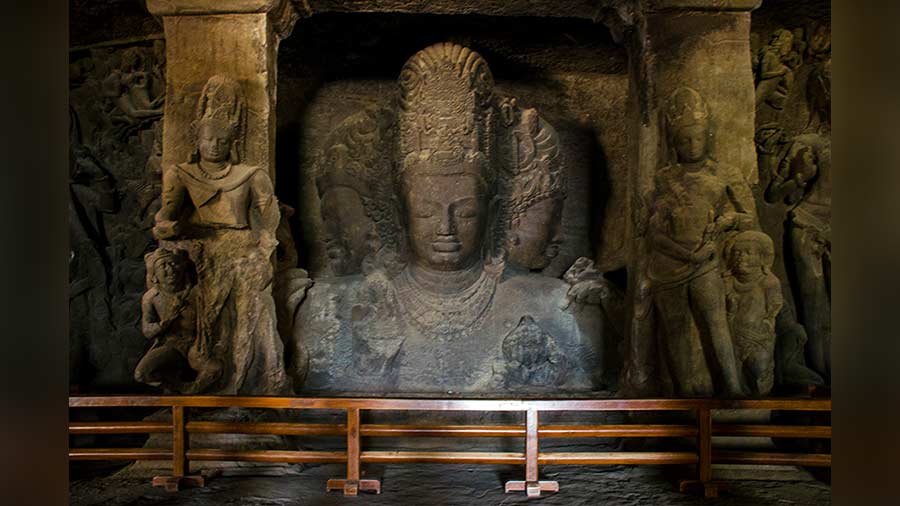
The Trimurti is the star attraction of the cave
Gangadhar (C on map): The panel on the right of the Trimurti shows Gangadhar Shiva. The panel depicts the story of Lord Shiva bringing the Ganges from heaven to earth. It has Lord Shiva and Parvati standing side by side. In between them stands a gana (dwarf jester). Bhaghirath can be seen kneeling down on the lower left corner.
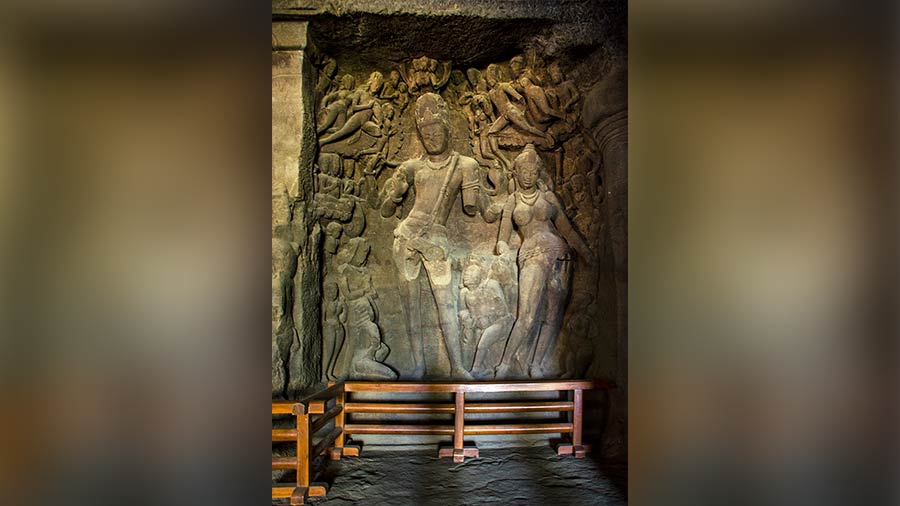
This panel depicts the story of Lord Shiva bringing the Ganges from heaven to earth
Ardhanarishvara (E on map): Left of the Trimurti panel is the panel depicting Ardhanarishvara, literally meaning the half female god. The female part represents Parvati while the male part represents Shiva.
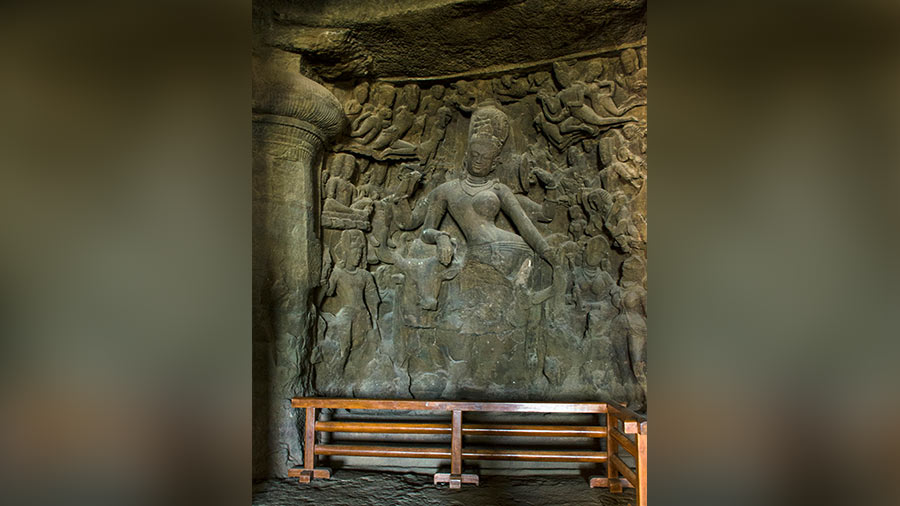
Ardhanarishvara
Shiva slaying Andhakasura (F on map): Each of the four corners of Cave 1 have intricate panels, and the north-west corner houses a panel depicting the killing of Andhakasura by Shiva. According to legend, each bit (or part) of Andhakasura that falls on the ground, creates a new Andhakasura. The Shiva statue in Elephanta carries a cup to prevent the blood of the demon from touching the ground.
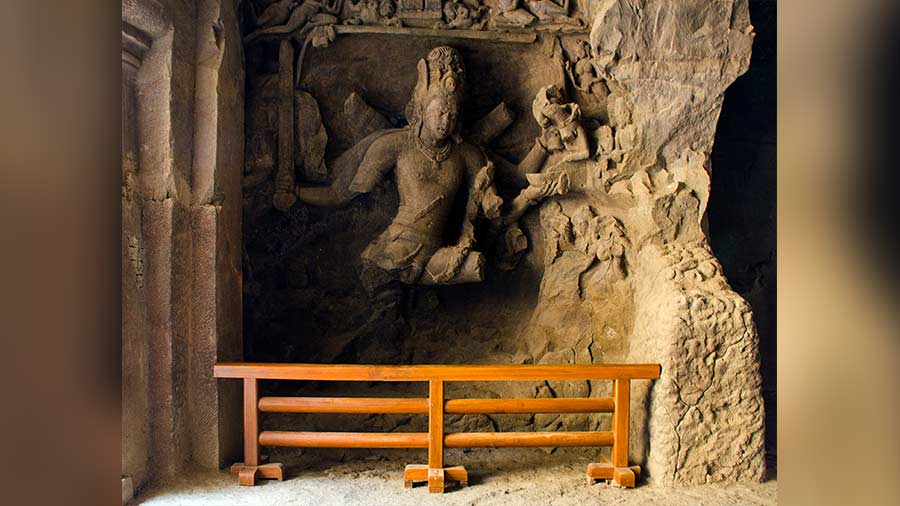
Shiva slaying Andhakasura
Ravana lifting Kailash (G on map): According to legend, Ravana wanted to uproot Kailash Parvat, the abode of Shiva, and bring it back home to Lanka. He managed to lift the mountain, but when Shiva put his left foot on the mountain it settled back to its original position. The panel depicts Ravana at the base; Shiva sits atop as one of his hands steadies a frightened Parvati.
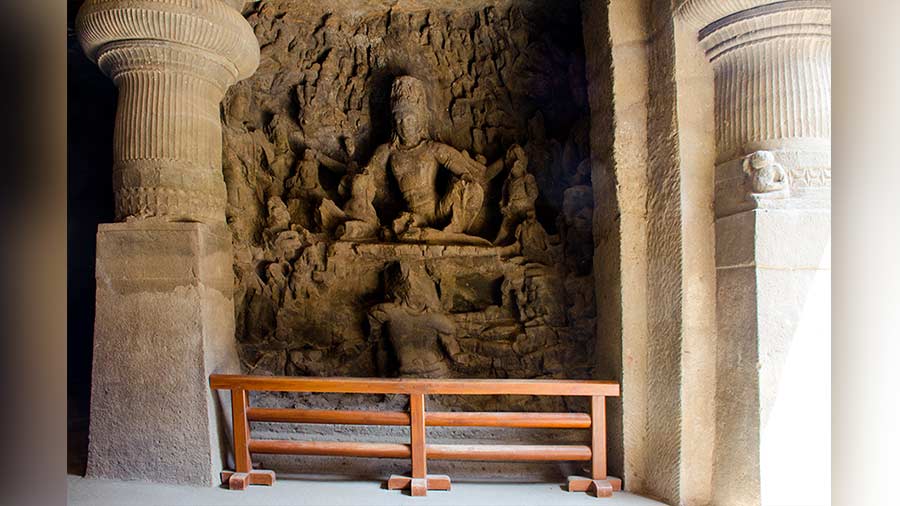
Ravana lifting Kailash
Shiva-Parvati (dice game) (H on map): This panel occupies the south-east corner of Cave 1. The panel shows Shiva and Parvati engaged in a game of dice in Kailash. The scene includes rocky terrain and clouds along with accessory figures, many of which have been damaged beyond recognition.
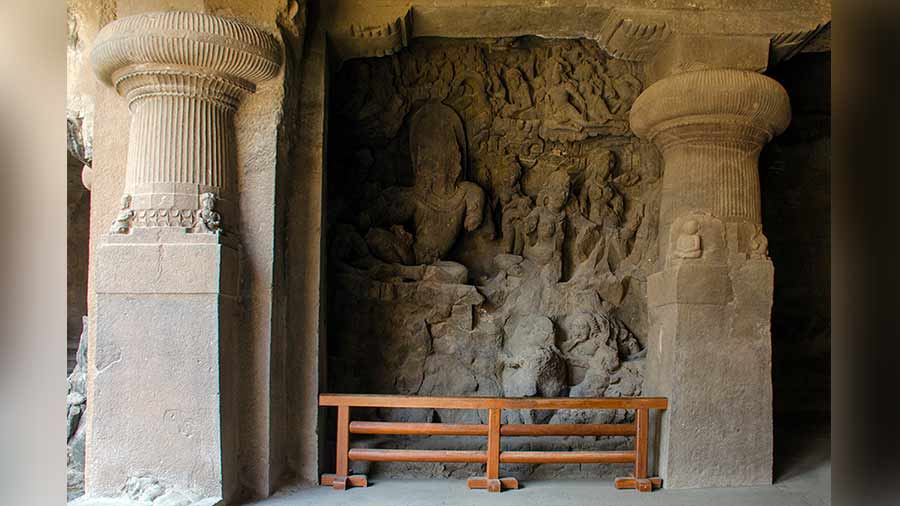
Shiva and Parvati engaged in a game of dice in Kailash
Shiva-Parvati marriage (I on map): This panel occupies the south-west corner of Cave 1. The panel depicts the marriage of Shiva and Parvati. Both Shiva and Parvati are in a standing position. Shiva is depicted as calm and young, while Parvati is shy and emotional. Brahma, the priest, is squatting on the floor to the right tending the yajna fire. The background shows gods, goddesses and celestial apsaras as witnesses to the grand wedding.
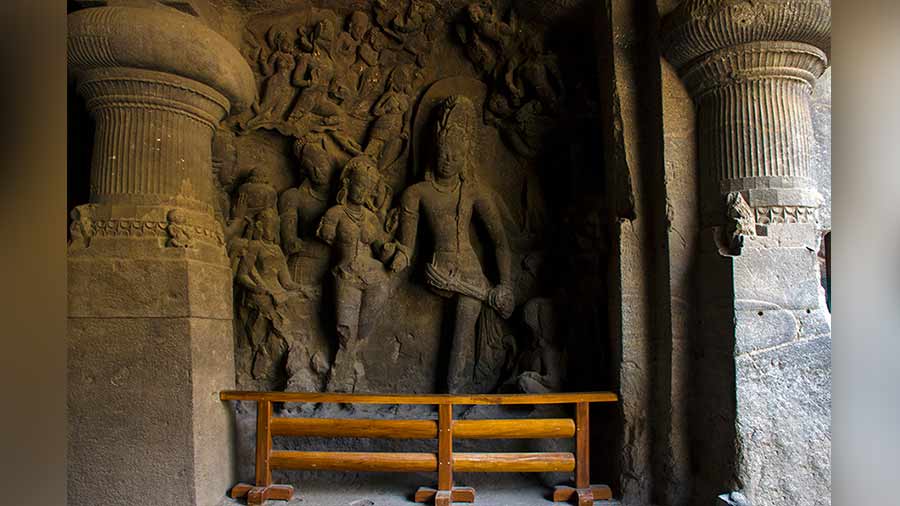
The panel depicting the marriage of Shiva and Parvati
Linga Shrine (J on Map): The Linga Shrine consists of a free-standing cubical cell located on the eastern side of Cave 1. All the four sides have doors approachable by a flight of stairs. Either side of the four doors are flanked with colossal statues of dvarapalas (gate guardians). The linga stands on a raised platform.
Western wing (K on map): Cave 1 has extensions on both the eastern and western sides. The western section is small and houses only a couple of sculptures of lesser quality, including Nataraj and Yogishvara.
Eastern wing (L on map): Much larger and grander than its western counterpart, this wing houses a Linga Shrine, similar to the one in the main hall guarded by statues of dvarpalas. The western wall of this section also contains a few sculptures.
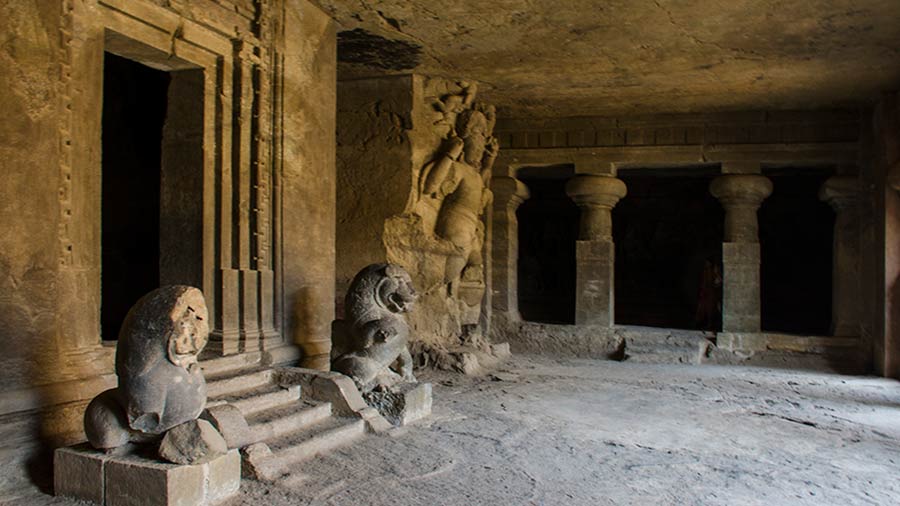
The eastern wing
Caves 2-5: Caves 2 to 5 of Elephanta are nothing spectacular. They are incomplete and are almost devoid of ornamentation. But since they are located next to Cave 1, it is advisable not to give them a miss.
Caves 6 and 7: These small caves are located high up the hill and have a difficult approach. Unless there is any special interest, they can be skipped.
Cannons: The Island of Elephanta stands on the mouth of the Thane Creek. The strategic position provided a view of the incoming ships and it was necessary to protect it from pirates. So, the island has its share of artillery, including cannons. Two of the cannons stand to this day and still overlooks the Thane Creek.
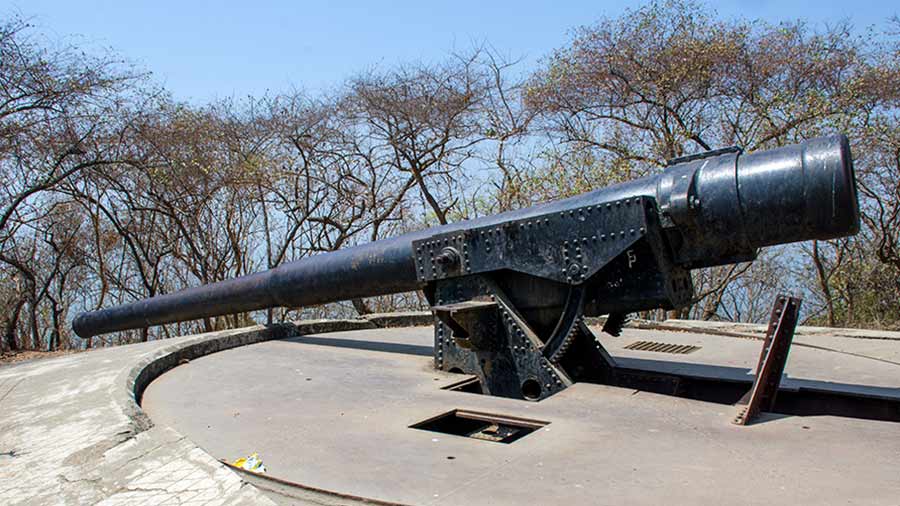
One of the cannons overlooking Thane Creek
Travel information
- Entry tickets for citizens of India, SAARC and BIMSTEC nations cost ₹40. For other nationals, it is ₹600. Children below 15 years get free entry
- Videography charge: ₹25 per camera
- Still photography: Free
- Gram Panchayat Tax: ₹5 per visitor
- Caves are open from 9.30am to 5.30pm (Monday closed)
